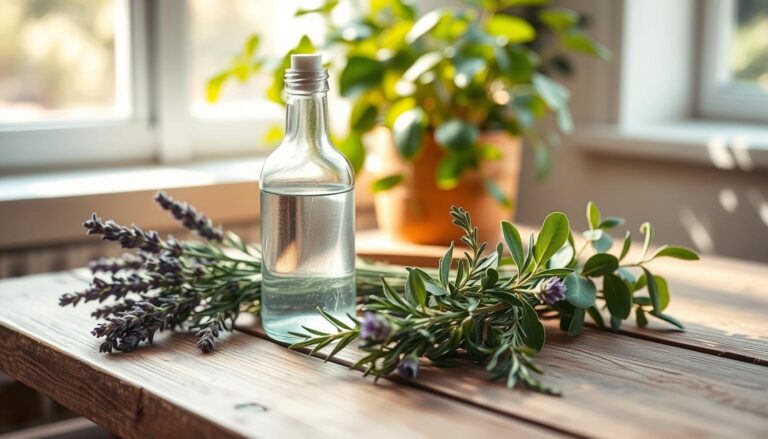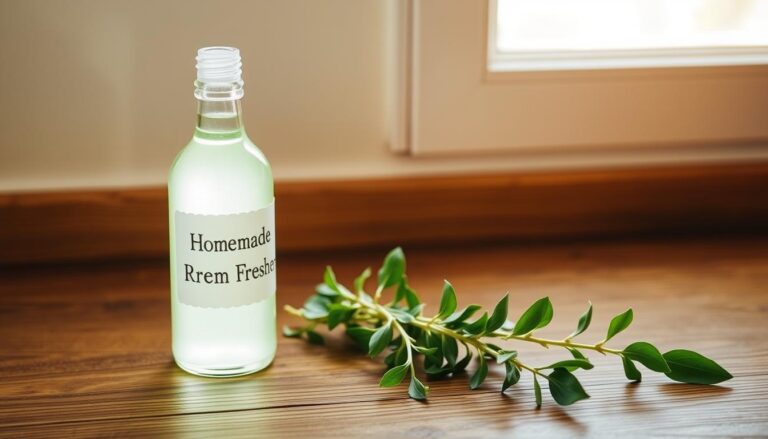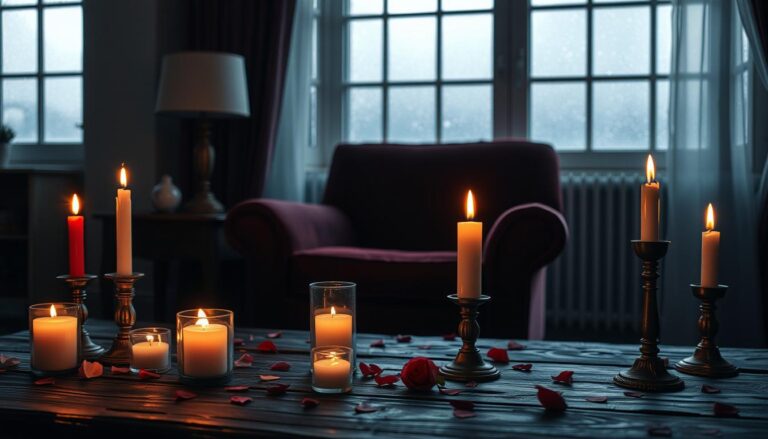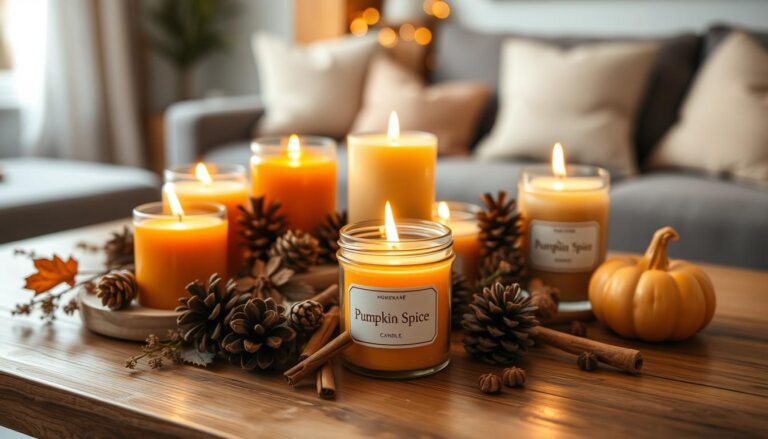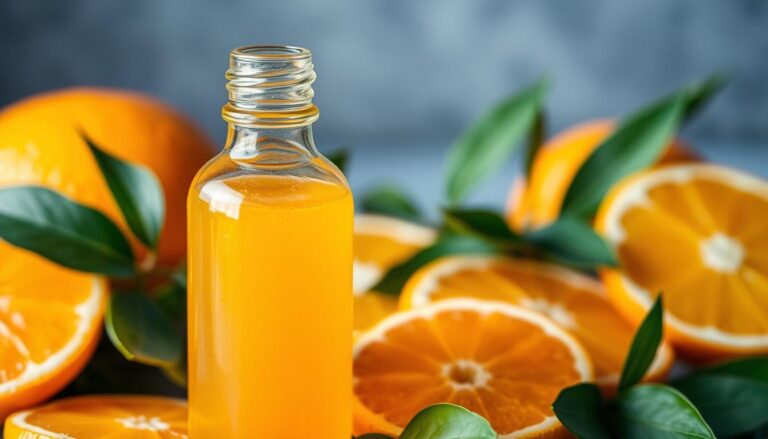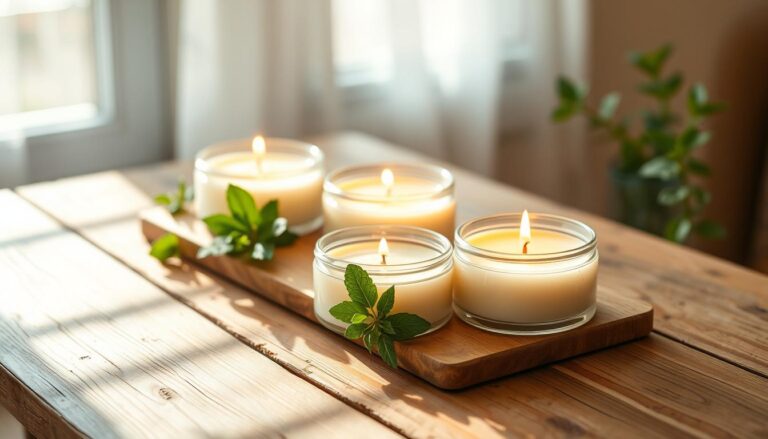Have you ever wanted to craft a fragrance that feels uniquely yours? This guide unlocks the joy of designing personalized perfumes using natural ingredients.
Whether you’re drawn to floral notes or earthy undertones, creating your signature scent is simpler than you think.
Natural ingredients offer more than just pleasant aromas—they let you avoid synthetic additives found in store-bought options.
You’ll need just a few supplies to start: carrier oils, aromatic extracts, and small bottles. The process blends artistry with basic chemistry, letting you experiment with layers that evolve on your skin.
One of the best parts? Homemade fragrances cost less than luxury brands while reflecting your taste. This article walks you through each step, from selecting balanced notes to mixing your first batch.
You’ll gain confidence to tweak recipes or invent entirely new combinations over time.
Key Takeaways
- Designing custom fragrances lets you express individuality while enjoying natural benefits
- Skip harsh chemicals by controlling every ingredient in your perfume
- Homemade scents often cost less than store-bought luxury options
- Fragrance creation connects modern self-expression with historical traditions
- Simple recipes help beginners achieve professional-looking results quickly
Step-by-Step Guide to Crafting your Own Scent
Ready to turn inspiration into your own bottled signature? Start by clearing a flat surface and lining up your materials.
You’ll need glass bottles, droppers, carrier liquid, and scent strips. Work near a window for ventilation—strong aromas need fresh air flow.
- Begin with base notes in your bottle.
- Add earthy tones like vetiver first, using 20% of your total mixture.
- Next, pour floral or herbal middle notes until they make up half the blend.
- Finish with citrusy top notes for the remaining 30%.
Cap the bottle and swirl gently. Don’t shake.
Dab a scent strip to test the balance. Notice how the layers unfold over 10 minutes? If the citrus fades too fast, add one drop of bergamot.
Too woody? A hint of geranium softens harsh edges.
Label each batch with dates and ratios.
Let mixtures rest 2 days before wearing. This “marrying time” helps layers bond.
Store finished perfumes in cool, dark places to preserve their character.
5 Beginner Formulas to get you Started on Making your Scent.
Here are 5 beginner-friendly essential oil formulas designed to teach the art of creating balanced scents using Top, Middle, and Base notes.
Each recipe totals 20 drops, perfect for use in:
- 100 ml room sprays
- 8 oz candles
- Diffuser blends
🌿 1. Fresh Balance
Top Note: 8 drops Lemon
Middle Note: 6 drops Lavender
Base Note: 6 drops Cedarwood
Effect: Bright, clean, and relaxing—ideal for daily use.
🌸 2. Floral Harmony
Top Note: 6 drops Bergamot
Middle Note: 8 drops Geranium
Base Note: 6 drops Sandalwood
Effect: Uplifting, romantic, and grounding.
🌲 3. Woodland Calm
Top Note: 5 drops Grapefruit
Middle Note: 6 drops Rosemary
Base Note: 9 drops Vetiver
Effect: Deep, grounding, and herbal—great for focus or meditation.
🍊 4. Citrus Warmth
Top Note: 8 drops Sweet Orange
Middle Note: 6 drops Ylang Ylang
Base Note: 6 drops Patchouli
Effect: A cozy and exotic citrus blend.
🌙 5. Evening Tranquility
Top Note: 6 drops Lavender
Middle Note: 6 drops Roman Chamomile
Base Note: 8 drops Frankincense
Effect: Perfect for winding down and relaxing before bed.
✅ Tip for Beginners:
- Stick to the general ratio: Top 30–40% / Middle 30–40% / Base 20–30%
- Always blend into a carrier if applying to skin (like 1 oz jojoba oil).
Introducing the Art of DIY Perfume Making
What if your favorite scent could do more than just smell nice? Plant extracts used in fragrances interact directly with your brain’s emotional center.
This connection lets you design aromas that uplift your mood or calm your thoughts.
Discovering the Power of Essential Oils
These concentrated plant extracts contain natural compounds that affect both body and mind.
Studies show citrus scents like bergamot has energy and focus enhancing benefits. On the other hand, lavender can ease stress.
Your nose sends these signals to the limbic system, linking smells to memories and feelings.
| Oil Type | Common Use | Emotional Effect |
|---|---|---|
| Peppermint | Energy boost | Enhances alertness |
| Ylang-Ylang | Relaxation | Reduces tension |
| Grapefruit | Mood lift | Promotes positivity |
Why DIY Perfume Is a Creative Journey
Mixing scents becomes personal storytelling. You decide whether to emphasize floral top notes or earthy base tones.
There’s science in balancing evaporation rates, but magic in discovering combinations that feel authentically you.
Start with simple pairings like lemon and rosemary. Track how different ratios change the aroma’s character.
Over time, you’ll develop an instinct for harmonizing unexpected elements, like pairing spicy ginger with sweet vanilla.
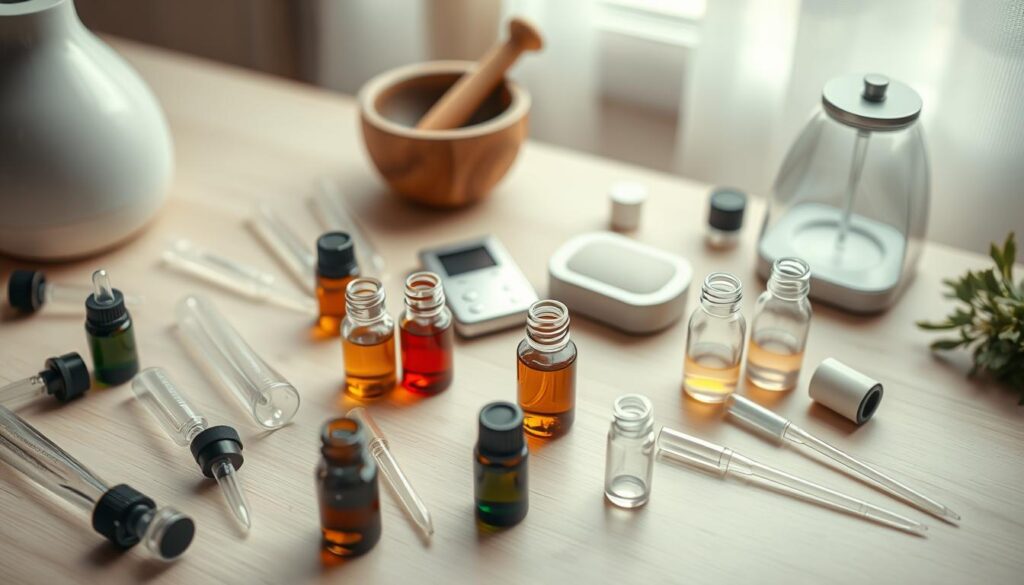
Getting Started with Creative Essential Oil Blending
Crafting your signature aroma begins with the right tools and know-how. Before mixing, set up a clean workspace and review safety protocols.
This foundation ensures smooth experimentation while protecting your skin and senses.
Gathering Your Tools and Ingredients
Start with three scent categories: bright top notes, floral middles, and earthy bases.
Glass bottles (1/24 oz. to 1/4 oz.) prevent chemical reactions.
Use separate droppers for each plant extract to avoid cross-contamination.
Protective gloves shield your hands during pouring. Perfume blotters help test combinations without skin contact.
Always label mixtures immediately because memory fades faster than lavender’s first whiff.
Understanding Dilution and Safety Basics
Most formulas use a 3% dilution: 20 drops per teaspoon of carrier liquid. Some extracts like cinnamon need weaker concentrations.
Track measurements precisely as one extra drop can overpower delicate jasmine.
Let mixtures mature 48 hours before judging. Dark glass bottles preserve freshness.
Never apply undiluted extracts directly.
Trust your instincts, but respect each component’s strength.
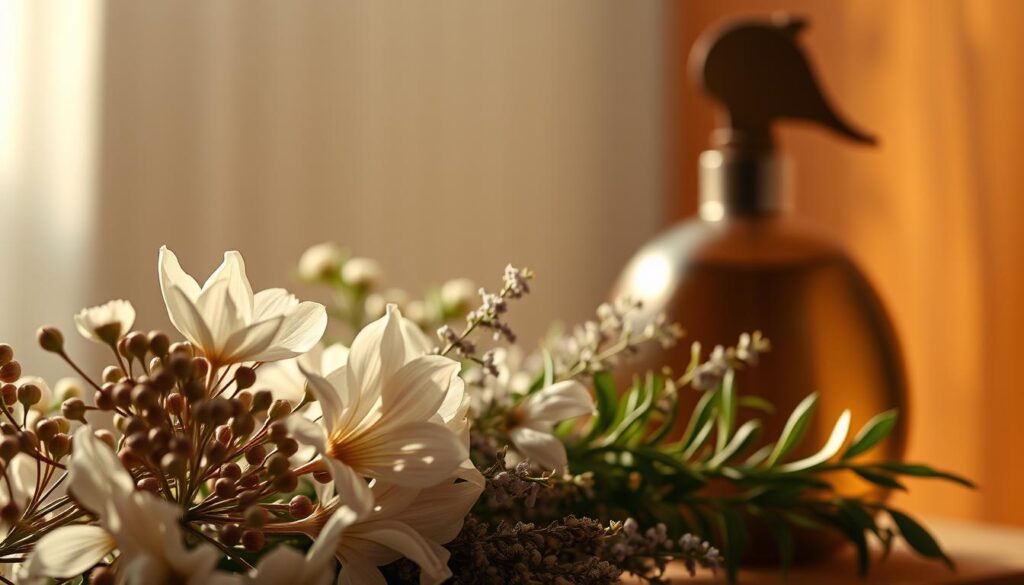
Decoding Fragrance Notes: Top, Middle, and Base
Imagine your perfume as a symphony where each scent plays at specific times.
This layered approach creates depth, transforming simple mixtures into complex experiences that evolve on your skin.
Identifying Your Aroma’s Layers
Top notes greet you first. Think citrus zing or herbal freshness. Bergamot and sweet orange spark immediate interest but fade within 30 minutes.
These initial impressions set the mood without overpowering.
Middle notes emerge next, forming the scent’s core. Lavender and clary sage build the main character, lingering for hours.
They smooth transitions between fleeting top notes and lasting base elements.
Base notes anchor your creation. Woody tones like sandalwood or frankincense develop slowly, providing structure.
These rich undertones can persist for days on fabric or skin.
Balancing Scent Profiles for Depth and Harmony
Follow the 30/50/20 ratio for balanced compositions: 30% bright top notes, 50% floral/herbal middles, 20% earthy bases. This formula prevents any single layer from dominating.
- Citrus pairs well with spicy or woody undertones
- Herbal elements like peppermint enhance earthy foundations
- Clary sage bridges floral and woody families seamlessly
Test blends on paper strips before skin application. Adjust ratios gradually—sometimes one extra drop of cedarwood transforms a good mix into greatness. Trust your nose, but let science guide your artistry.
Remember: Your first attempt might surprise you.
Scents transform on skin as body heat activates ingredients. Keep notes on what works, and soon you’ll craft fragrances that feel like second skin.
FAQ
What basic supplies do I need to start blending fragrances?
You’ll need carrier oils (like jojoba or sweet almond), a selection of scented oils, glass droppers, dark glass bottles, and a notebook to track your recipes. Start with a few versatile options like lavender or bergamot.
How do I choose which scents work well together?
Focus on balancing top, middle, and base layers. For example, pair citrusy notes (lemon) with floral (rose) and earthy tones (patchouli). Experiment with small batches to find combinations that resonate with your preferences.
Why is dilution important when working with concentrated oils?
Undiluted oils can irritate skin or overwhelm your senses. Mixing them with a carrier oil ensures safety and helps the aroma last longer. A typical ratio is 2% essential oil to 98% carrier oil for body applications.
Can I recreate my favorite store-bought perfume at home?
Yes! Start by identifying its dominant notes—citrus, spice, or woodsy elements, then layer similar oils. Keep adjusting ratios until you match the depth and complexity you love.
How long does a homemade blend typically last?
Most mixtures stay fresh for 6–12 months if stored in a cool, dark place. Citrus-based scents may fade faster, while resinous oils like frankincense age well over time.
What’s a common mistake beginners should avoid?
Overloading too many notes at once. Begin with 2–3 oils, let the blend settle for 24 hours, then tweak. Patience helps you refine the aroma without sensory overload.
